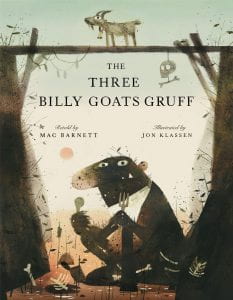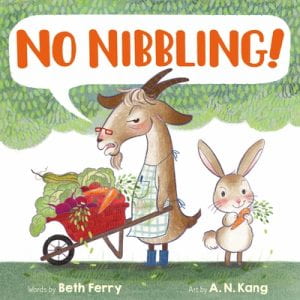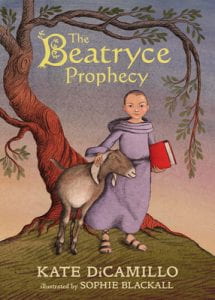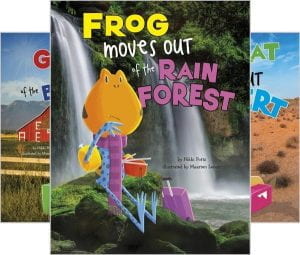 Barnett, Mac. The Three Billy Goats Gruff. Illustrated by Jon Klassen. Orchard Books, and Imprint of Scholastic, 2022. 978-1-338-67384-5. $18.99. 48 p. Grades K-3.
Barnett, Mac. The Three Billy Goats Gruff. Illustrated by Jon Klassen. Orchard Books, and Imprint of Scholastic, 2022. 978-1-338-67384-5. $18.99. 48 p. Grades K-3.
This is a beautiful and amusing retelling of the traditional Norwegian trickster tale, brilliantly illustrated by Jon Klassen. A hungry troll lives beneath a bridge that connects the farmland to a grassy hill. Barnett’s classic droll humor makes this troll particularly amusing – he is so desperate he even eats his own ear wax and belly button lint. When a small goat crosses the bridge the troll dances and chants in rhyming verse, explaining all the ways he enjoys eating goat. The small goat convinces the troll to let him go, claiming that his big brother will follow him over the bridge. The big brother has a lot more meat on his bones and will make a much tastier meal for the troll. The troll lets the little goat go and praises himself for tricking the small goat into telling him about a better opportunity. Next, of course, comes the big brother goat. Again, the troll launches into a hilarious, rhyming litany of all the ways he will prepare the big brother goat for dinner. The big brother goat explains he is not the biggest of the goat brothers and would spoil the troll’s appetite. The greedy troll lets this second goat pass over the bridge without harm. As the troll waits in anticipation of his large meal he considers the words he will choose for his next rhyming recipe. The words “strudel” and “escargot” have him particularly perplexed. Along comes the biggest goat. This third goat is so big that we only can see his hairy legs on the full-bleed-spread. This goat is much larger than the troll bargained for; he is so shocked he cannot even form a rhyme. The biggest goat firmly tells the troll he will not eat him, and then proceeds to head-butt the troll off of the bridge. The troll splashes into the water below and falls down a big waterfall, which leads to an even bigger waterfall, which leads to an absolutely enormous waterfall. The three goat brothers are reunited on the grassy ridge, where they live happily ever after.
THOUGHTS: Barnett and Klassen are fabulous as always in this classic fairy tale with a twist. The book works exceedingly well as a read aloud. Children will be delighted in the rhyming antics of the troll, and the reveal of the third goat is absolutely brilliant. An embedded lesson in superlative adjectives is a delightful added bonus.
Picture Book Anne McKernan, Council Rock SD
Fairy Tale



